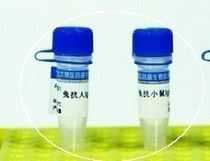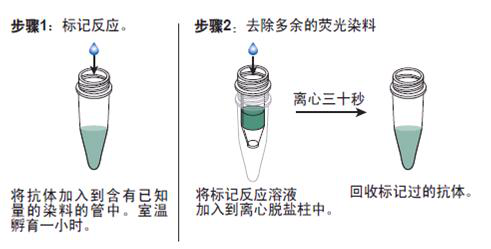
|

| 产地 | 进口、国产 |
| 品牌 | 上海莼试 |
| 保存条件 | Store at -20 °C |
| 货号 | CS10725 |
| 应用范围 | WB=1:100-500 ELISA=1:500-1000 IP=1:20-100 IHC-P=1:100-500 IHC-F=1:100-500 IF=1:100-500 |
| CAS编号 | |
| 抗体名 | Anti-p95 NBS1 |
| 克隆性 | |
| 靶点 | 详见说明书 |
| 适应物种 | 详见说明书 |
| 形态 | 详见说明书 |
| 宿主 | 详见说明书 |
| 亚型 | IgG |
| 标识物 | 详见说明书 |
| 浓度 | 1mg/1ml% |
| 免疫原 | KLH conjugated synthetic peptide derived from human NBS1 C-terminus |
产品订购信息:
英文名称 Anti-p95 NBS1
中文名称 DNA修复蛋白NBS1抗体费用
别 名 p95 NBS1; Nijmegen breakage syndrome 1; Nijmegen breakage syndrome 1 (nibrin); AT V1; AT V2; ATV; Cell cycle regulatory protein p95; FLJ10155; MGC87362; MGC93174; NBN; NBS 1; NBS; NBS1; Nibrin; Nijmegen breakage syndrome; Nijmegen breakage syndrome protein 1; p95; NBN_HUMAN; Nibrin; Nijmegen breakage syndrome protein 1.


浓 度 1mg/1ml
规 格 0.2ml/200μg
抗体来源 Rabbit
克隆类型 polyclonal
交叉反应 Human, Mouse, Rat, Chicken, Dog, Cow, Horse, Rabbit
产品类型 一抗
研究领域 细胞生物 免疫学 染色质和核信号 信号转导 转录调节因子
蛋白分子量 predicted molecular weight: 85kDa
性 状 Lyophilized or Liquid
免 疫 原 KLH conjugated synthetic peptide derived from human NBS1 C-terminus
亚 型 IgG
纯化方法 affinity purified by Protein A
储 存 液 0.01M PBS, pH 7.4 with 10 mg/ml BSA and 0.1% Sodium azide
DNA修复蛋白NBS1抗体费用 产品应用 WB=1:100-500 ELISA=1:500-1000 IP=1:20-100 IHC-P=1:100-500 IHC-F=1:100-500 IF=1:100-500
(石蜡切片需做抗原修复)
not yet tested in other applications.
optimal dilutions/concentrations should be determined by the end user.
保存条件 Store at -20 °C for one year. Avoid repeated freeze/thaw cycles. The lyophilized antibody is stable at room temperature for at least one month and for greater than a year when kept at -20°C. When reconstituted in sterile pH 7.4 0.01M PBS or diluent of antibody the antibody is stable for at least two weeks at 2-4 °C.
Important Note This product as supplied is intended for research use only, not for use in human, therapeutic or diagnostic applications.
产品介绍 Component of the MRE11/RAD50/NBN (MRN complex) which plays a critical role in the cellular response to DNA damage and the maintenance of chromosome integrity. The complex is involved in double-strand break (DSB) repair, DNA recombination, maintenance of telomere integrity, cell cycle checkpoint control and meiosis. The complex possesses single-strand endonuclease activity and double-strand-specific 3'-5' exonuclease activity, which are provided by MRE11A. RAD50 may be required to bind DNA ends and hold them in close proximity. NBN modulate the DNA damage signal sensing by recruiting PI3/PI4-kinase family members ATM, ATR, and probably DNA-PKcs to the DNA damage sites and activating their functions. It can also recruit MRE11 and RAD50 to the proximity of DSBs by an interaction with the histone H2AX. NBN also functions in telomere length maintenance by generating the 3' overhang which serves as a primer for telomerase dependent telomere elongation. NBN is a major player in the control of intra-S-phase checkpoint and there is some evidence that NBN is involved in G1 and G2 checkpoints. The roles of NBS1/MRN encompass DNA damage sensor, signal transducer, and effector, which enable cells to maintain DNA integrity and genomic stability.
Function : Component of the MRE11-RAD50-NBN (MRN complex) which plays a critical role in the cellular response to DNA damage and the maintenance of chromosome integrity. The complex is involved in double-strand break (DSB) repair, DNA recombination, maintenance of telomere integrity, cell cycle checkpoint control and meiosis. The complex possesses single-strand endonuclease activity and double-strand-specific 3'-5' exonuclease activity, which are provided by MRE11A. RAD50 may be required to bind DNA ends and hold them in close proximity. NBN modulate the DNA damage signal sensing by recruiting PI3/PI4-kinase family members ATM, ATR, and probably DNA-PKcs to the DNA damage sites and activating their functions. It can also recruit MRE11 and RAD50 to the proximity of DSBs by an interaction with the histone H2AX. NBN also functions in telomere length maintenance by generating the 3' overhang which serves as a primer for telomerase dependent telomere elongation. NBN is a major player in the control of intra-S-phase checkpoint and there is some evidence that NBN is involved in G1 and G2 checkpoints. The roles of NBS1/MRN encompass DNA damage sensor, signal transducer, and effector, which enable cells to maintain DNA integrity and genomic stability. Forms a complex with RBBP8 to link DNA double-strand break sensing to resection.
Subunit : Component of the MRN complex composed of two heterodimers RAD50/MRE11A associated with a single NBN. Component of the BASC complex, at least composed of BRCA1, MSH2, MSH6, MLH1, ATM, BLM, RAD50 and MRE11A (By similarity). Interacts with histone H2AFX this requires phosphorylation of H2AFX on 'Ser-139'. Interacts with HJURP, INTS3, KPNA2 and TERF2. Interacts with RBBP8; the interaction links the role of the MRN complex in DNA double-strand break sensing to resection. Interacts with SP100; recruits NBN to PML bodies.
Subcellular Location : Nucleus (By similarity). Nucleus, PML body. Chromosome, telomere (By similarity). Note=Localizes to discrete nuclear foci after treatment with genotoxic agents (By similarity).
Post-translational modifications : Phosphorylated by ATM in response of ionizing radiation, and such phosphorylation is responsible intra-S phase checkpoint control and telomere maintenance.
DISEASE : Nijmegen breakage syndrome (NBS) [MIM:251260]: A disorder characterized by chromosomal instability, radiation sensitivity, microcephaly, growth retardation, immunodeficiency and predisposition to cancer, particularly to lymphoid malignancies. Note=The disease is caused by mutations affecting the gene represented in this entry.
Breast cancer (BC) [MIM:114480]: A common malignancy originating from breast epithelial tissue. Breast neoplasms can be distinguished by their histologic pattern. Invasive ductal carcinoma is by far the most common type. Breast cancer is etiologically and genetically heterogeneous. Important genetic factors have been indicated by familial occurrence and bilateral involvement. Mutations at more than one locus can be involved in different families or even in the same case. Note=Disease susceptibility is associated with variations affecting the gene represented in this entry.
Aplastic anemia (AA) [MIM:609135]: A form of anemia in which the bone marrow fails to produce adequate numbers of peripheral blood elements. It is characterized by peripheral pancytopenia and marrow hypoplasia. Note=Disease susceptibility may be associated with variations affecting the gene represented in this entry.
Note=Defects in NBN might play a role in the pathogenesis of childhood acute lymphoblastic leukemia (ALL).
Similarity : Contains 1 BRCT domain.
Contains 1 FHA domain.
Database links : UniProtKB/Swiss-Prot: O60934.1
NBS1蛋白可与Mre11和Rad50蛋白形成一个Mre11-Rad50-NBS1复合物,在DNA的复制和DNA双链断裂的修复等过程中起重要作用。

anti-p- Beta catenin/FITC 荧光素标记磷酸化β-连环蛋白抗体IgGMulti-class antibodies规格: 0.2ml
Anti-HCN4/FITC 荧光素标记环化核苷酸调控阳离子通道蛋白亚型4IgGMulti-class antibodies规格: 0.2ml
Rhesus antibody Rh CENPP 着丝粒蛋白P抗体 规格 0.2ml
Erdj5/DNAJC10 Erdj5/DNAJC10多肽 0.5mg
IFN gamma 英文名称: 干扰素-γ/IFN-γ抗体 0.1ml
Rhesus antibody Rh TIP47/M6PRBP1 脂滴相关蛋白TIP47抗体 规格 0.2ml
Anti-HCN4/FITC 荧光素标记环化核苷酸调控阳离子通道蛋白亚型4IgGMulti-class antibodies规格: 0.2ml
Human major histocompatibility complex II ,MHC II /HLA- II ELISA Kit 人主要组织相容性复合体Ⅱ类Multi-class antibodies规格: 48T
Anti-Phospho-RSK3 (Thr353/356) 磷酸化核糖体蛋白S6激酶家族RSK3抗体Multi-class antibodies规格: 0.1ml
Rhesus antibody Rh GRO gamma/CXCL3 生长调节致癌基因gamma(GROγ)抗体 规格 0.1ml
F VIII Ag ELISA Kit 大鼠第八因子相关抗原 96T
OPRS1 英文名称: 衰老相关Sigma受体蛋白抗体 0.2ml
phospho-B Raf (Thr598) 英文名称: 磷酸化B-Raf抗体 0.1ml
Anti-Phospho-RSK3 (Thr353/356) 磷酸化核糖体蛋白S6激酶家族RSK3抗体Multi-class antibodies规格: 0.1ml
Human Acylation Stimulating Protein,ASP ELISA Kit 人酰化刺激蛋白Multi-class antibodies规格: 48T
Anti-Substance P P物质抗体Multi-class antibodies规格: 0.1ml
Rhesus antibody Rh Goat Anti-Mouse IgG/PE-Cy5.5 PE-Cy5.5标记的羊抗小鼠IgG 规格 0.1ml
MC Ab ELISA Kit 大鼠黑色素细胞抗体 96T
Phospho-NFKB1(Ser932) 英文名称: 磷酸化细胞核因子p50/k基因结合核因子抗体 0.1ml
Bax beta 英文名称: BCL2相关X蛋白抗体 0.2ml
Anti-Substance P P物质抗体Multi-class antibodies规格: 0.1ml
CL-0074DLD-1(人腺癌细胞)5×106cells/瓶×2
FCGR3B Others Human 人 CD16b / FCGR3B CHO细胞裂解液 (阳性对照)
EndoFectagen? 内皮细胞转染试剂盒
牛陀螺状细胞;BT 鸡细胞,DT40细胞 Kert-3细胞,小鼠细胞
EB病毒转化的人B淋巴细胞(傣族);KM9403
FABP4 Others Mouse 小鼠 FABP4 / ALBP 人细胞裂解液 (阳性对照)
CL-0072Daudi(人细胞)5×106cells/瓶×2
SDF2 Others Human 人 SDF2 杆状病毒-昆虫细胞裂解液 (阳性对照)
细胞凋亡蛋白酶-3分析试剂盒CAS
HT-29细胞,人细胞 人胚肾细胞,293细胞 肾系膜细胞Many types of cells包装:5 ×105次方(1ml)
家兔骨髓间充质干细胞;2012083MSC
SFRP4 Others Human 人 sFRP4 人细胞裂解液 (阳性对照)
DNA修复蛋白NBS1抗体费用 MBL2 Others Human 人 MBL2 / MBL / COLEC1 CHO细胞裂解液 (阳性对照)
CL-0090Hacat(人永生化角质形成细胞)5×106cells/瓶×2
人神经细胞裂解物HNL
牛肾细胞;MDBK 人咽鳞癌细胞,FaDu细胞 Nb2-11细胞,小鼠细胞
EB病毒转化的人B淋巴细胞;KM932
THSD1 Others Mouse 小鼠 THSD1 / TMTSP 人细胞裂解液 (阳性对照)

抗体的生物素化标记实验要点:
1. DNA修复蛋白NBS1抗体费用 如在反应混合液中有叠氮钠或游离氨基存在,会抑制标记反应。因此,蛋白质在反应前要对 0.1mol/L碳酸氢钠缓冲液或0.5mol/L硼酸缓冲液充分透析;
2.所用的NHSB及待生物素化蛋白质之间的分子比按蛋白质表面的ε-氨基的密度会有所不同,选择不当则影响标记的效率,应先用几个不同的分子比来筛选最适条件;
3.用NHSB量过量也是不利的,抗原的结合位点可能因此被封闭,导致抗体失活;
4.由于抗体的氨基不易接近可能造成生物素化不足,此时可加入去污剂如 Triton x-100, Tween20等;
5.当游离ε-氨基(赖氨酸残基的氨基)存在于抗体的抗原结合位点时,或位于酶的催化位点时,生物素化会降低或损伤抗体蛋白的结合力或活性;
6.生物素还可能与不同的功能基团,如羰基、氨基、巯基、异咪唑基及*基,也可与糖基共价结合;
7.交联反应后,应充分透析,否则,残余的生物素会对生物素化抗体与亲和素的结合产生竞争作用;
8.在细胞的荧光标记实验中,中和亲和素的本底低,但由于链霉亲和素含有少量正电荷,故对某些细胞可导致高本底。
抗体的鉴定:
1)DNA修复蛋白NBS1抗体费用 抗体的效价鉴定:不管是用于诊断还是用于,制备抗体的目的都是要求较高效价。不同的抗原制备的抗体,要求的效价不一。鉴定效价的方法很多,包括有试管凝集反应,琼脂扩散试验,酶联免疫吸附试验等。常用的抗原所制备的抗体一般都有约成的鉴定效价的方法,以资比较。如制备抗抗体的效价,一般就采用琼脂扩散试验来鉴定。
2)抗体的特异性鉴定:抗体的特异性是指与相应抗原或近似抗原物质的识别能力。抗体的特异性高,它的识别能力就强。衡量特异性通常以交叉反应率来表示。交叉反应率可用竞争抑制试验测定。以不同浓度抗原和近似抗原分别做竞争抑制曲线,计算各自的结合率,求出各自在IC50时的浓度,并按公式计算交叉反应率。
如果所用抗原浓度IC50浓度为pg/管,而一些近似抗原物质的IC50浓度几乎是无穷大时,表示这一抗血清与其他抗原物质的交叉反应率近似为0,即该血清的特异性较好。
3)抗体亲和力:是指抗体和抗原结合的牢固程度。亲和力的高低是由抗原分子的大小,抗体分子的结合位点与抗原决定簇之间立体构型的合适度决定的。有助于维持抗原抗体复合物稳定的分子间力有氢键,疏水键,侧链相反电荷基因的库仑力,范德华力和空间斥力。亲和力常以亲和常数K表示,K的单位是L/mol。抗体亲和力的测定对抗体的筛选,确定抗体的用途,验证抗体的均一性等均有重要意义。